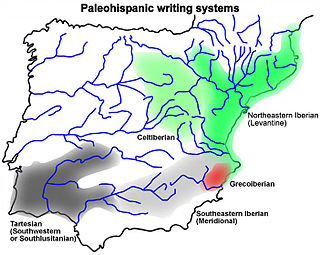
Tartessos is, as defined by archaeological discoveries, a historical civilization settled in the southern Iberian Peninsula characterized by its mixture of local Paleohispanic and Phoenician traits. It had a writing system, identified as Tartessian, that includes some 97 inscriptions in a Tartessian language.
The Lusitanians were an Indo-European-speaking people living in the far west of the Iberian Peninsula, in present-day central Portugal and Extremadura and Castilla y Leon of Spain. After its conquest by the Romans, the land was subsequently incorporated as a Roman province named after them (Lusitania).

Conistorgis was the main city of the Conii or Cynetes. In the Conii language it probably meant "city of the Conii". The Celtici seem to have been present there.

Faro District is the southernmost district of Portugal. The area is the same as that of the Algarve region. The administrative centre, or district capital, is the city of Faro. It borders Spain.

The Vettones were an Iron Age pre-Roman people of the Iberian Peninsula.

The Celtici were a Celtic tribe or group of tribes of the Iberian Peninsula, inhabiting three definite areas: in what today are the regions of Alentejo and the Algarve in Portugal; in the Province of Badajoz and north of Province of Huelva in Spain, in the ancient Baeturia; and along the coastal areas of Galicia. Classical authors give various accounts of the Celtici's relationships with the Gallaeci, Celtiberians and Turdetani.

The Paesuri or Paesures were an ancient pre-Roman people of Lusitania, akin to the Lusitani, to whom they were a dependent tribe.

The Turduli or Turtuli were an ancient pre-Roman people of the southwestern Iberian Peninsula.

The Turduli Veteres, translated as "Ancient Turduli" or "Old Turduli" were an ancient pre-Roman tribe of present day Portugal, akin to the Calaicians or Gallaeci and Lusitanians.

Hispano-Celtic is a term for all forms of Celtic spoken in the Iberian Peninsula before the arrival of the Romans. In particular, it includes:

Tartessian is an extinct Paleo-Hispanic language found in the Southwestern inscriptions of the Iberian Peninsula, mainly located in the south of Portugal, and the southwest of Spain. There are 95 such inscriptions; the longest has 82 readable signs. Around one third of them were found in Early Iron Age necropolises or other Iron Age burial sites associated with rich complex burials. It is usual to date them to the 7th century BC and to consider the southwestern script to be the most ancient Paleo-Hispanic script, with characters most closely resembling specific Phoenician letter forms found in inscriptions dated to c. 825 BC. Five of the inscriptions occur on stelae that have been interpreted as Late Bronze Age carved warrior gear from the Urnfield culture.

The Vaccaei or Vaccei were a pre-Roman Celtic people of Spain, who inhabited the sedimentary plains of the central Duero valley, in the Meseta Central of northern Hispania.

The Lusones were an ancient Celtiberian (Pre-Roman) people of the Iberian Peninsula, who lived in the high Tajuña River valley, northeast of Guadalajara. They were eliminated by the Romans as a significant threat in the end of the 2nd century BC.

The Southwest Script, also known as Southwestern Script, Tartessian, South Lusitanian, and Conii script, is a Paleohispanic script used to write an unknown language typically identified as Tartessian. Southwest inscriptions have been found primarily in the southwestern quadrant of the Iberian Peninsula, mostly in the south of Portugal, but also in Spain.

Prehistory in the Iberian peninsula begins with the arrival of the first Homo genus representatives from Africa, which may range from c. 1.5 million years (Ma) ago to c. 1.25 Ma ago, depending on the dating technique employed, so it is set at c. 1.3 Ma ago for convenience.

The Bardili were a small, pre-Roman tribe of the Iberian Peninsula, and an offshoot of the widespread Turduli people, who lived in what is now southwestern Portugal in the 5th-1st centuries BC.
This section of the timeline of Iberian history concerns events from before the Carthaginian conquests.
















